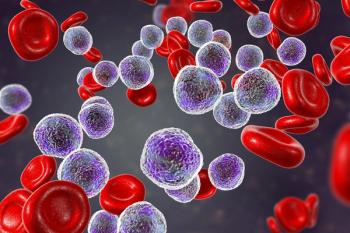
- Oncology Vol 28 No 1S
- Volume 28
- Issue 1S
(P078) Using a Deformable Bladder Planning Contour Reduces Repeat CBCTs During Prostate Image-Guided Intensity-Modulated Radiation Therapy
To determine if a deformable bladder planning contour (DBPC) can help minimize repeat cone beam computed tomographies (CBCTs) during a course of prostate image-guided volumetric arc radiation therapy (IG-VMAT).
Edward Obedian, MD, John Keane, MS, Fil Olivieri, CMD, Denise Capece, RTT, Carl DeCaro, RTT, Shawn H Zimberg, MD; Advanced Radiation Centers of New York
Purpose: To determine if a deformable bladder planning contour (DBPC) can help minimize repeat cone beam computed tomographies (CBCTs) during a course of prostate image-guided volumetric arc radiation therapy (IG-VMAT).
Materials and Methods: Between September 24, 2013 and November 1, 2013, a total of 246 patients were consecutively treated for prostate cancer using image-guided intensity-modulated radiation therapy (IG-IMRT) with VMAT, either in the definitive or postprostatectomy setting. Daily kilovoltage (kV) CBCT scans provided image guidance for all patients with matches made to gold fiducial markers for those with intact prostates or to the prostate bed/bony anatomy for those postprostatectomy. A radiation therapist and a physician prospectively reviewed each CBCT on a daily basis, and the images were compared with the CT simulation images, which included the prostate or prostate bed, seminal vesicles, nodal region if applicable, planning target volume (PTV), rectum, and bladder. Patients were typically simulated with a full bladder. During treatment planning, our dosimetry team manually generated a DBPC as a structure typically smaller than the bladder at simulation but one that met our minimum bladder dose constraints: bladder D10 and D50 of 7,200 cGy and 4,000 cGy, respectively. These dose constraints were notably more stringent than the current bladder dose constraints utilized by the ongoing Radiation Therapy Oncology Group (RTOG) protocol 08-15 (D15, D25, D35, and D50 of 8,000, 7,500, 7,000, and 6,500 cGy, respectively). These comparisons and whether a repeat CBCT was performed due to a bladder issue were all recorded. Prior to a repeat CBCT for a bladder issue, the patients were taken off the table, typically to drink more water or rarely to void urine. The decision to repeat the CBCT was made at the discretion of the radiation oncologist.
Results: A total of 4,509 CBCT scans on 246 consecutively treated prostate cancer patients were prospectively reviewed. Further, 429 (9.5%) CBCT scans were repeated. Of the repeat scans, 230 (54%) CBCTs were repeated because of a bladder issue. The bladder size on treatment was smaller than, larger than, or the same size as the DBPC in 352 (8.5%) cases, 2,920 (69.5%) cases, and 926 (22%) cases, respectively. When the bladder at treatment was smaller than the DBPC, a repeat CBCT was performed in 218 cases (62%). When the bladder at treatment was the same size or larger than the DBPC, a repeat CBCT was performed in 25 cases (0.65%).
Conclusions: An underfilled bladder volume is the most common reason for repeat CBCT scans in IG-VMAT for prostate cancer. The use of a simple dosimetric supplemental bladder structure known as DBPC can greatly reduce the number of repeat CBCT scans due to incompletely filled bladders on treatment without compromising the ability to meet bladder dose constraints. Using a smaller DBPC that meets RTOG criteria may further improve these results.
Articles in this issue
Newsletter
Stay up to date on recent advances in the multidisciplinary approach to cancer.


















































































